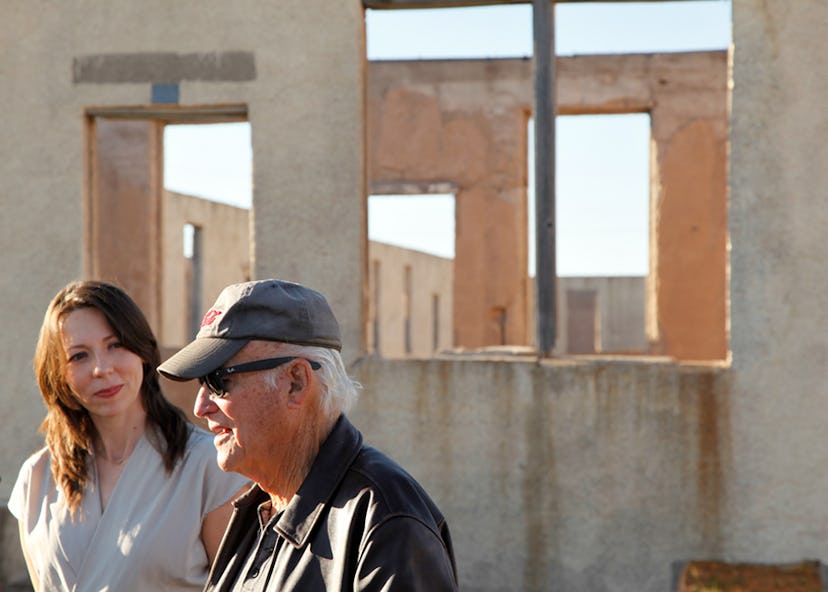Robert Irwin’s Grand Stand in Marfa
At 87 years old, the legendary artist is unveiling his most ambitious project to date, in a fort in the Texas desert.

Late last week in Marfa, Texas, the artist Robert Irwin was overseeing the final touches on his 10,000-square foot installation at the Chinati Foundation. But there was a problem. The last few staples that would hold a panel of white scrim in place were going in “wonky,” as his team lamented, and they needed to get them right before they could cut out the final doorway.
“What are the challenges that we faced in making the project? I’m surprised there weren’t more,” said Jenny Moore, Chinati’s director. As far as set-backs go, wonky staples are nominal, considering that this hugely ambitious project has been in the works since 1999.
A rebuilding of the demolished hospital at the former Fort D.A. Russell (which Donald Judd acquired in the late 70’s with the help of Dia Art Foundation), it’s the only permanent and freestanding work of art by Irwin. To a non-discerning eye, it may appear to be just a building, but look closely and you’ll notice that the windows are taller than they should be, and the walls are disproportionately thick.
“That’s the main event, all the windows. People think they’re looking for artwork but what they’re actually seeing is beautiful nature,” said Irwin. “I liked the architecture of the fort. All I did was take that form and elaborate it—make the walls thicker, so you get a more substantial physicality to look out of. A real sense of frame.”
What the walls are framing is the big Texas sky, which is what, aside from his friendship with Judd, attracted Irwin to Marfa in the first place. “The clouds are right on top of your head; it’s like a wild west show everyday,” he said.
Robert Irwin Takes Marfa
Robert Irwin: Marfa 2016 (before completion)
Robert Irwin: Marfa 2016 (before completion)
Robert Irwin Project, in process at Chinati Foundation. Courtesy of Chinati Foundation.
Robert Irwin Project at Chinati Foundation. Courtesy of @rulegallery.
Robert Irwin Project at Chinati Foundation. Courtesy of @viecher.
Robert Irwin Project at Chianti Foundation. Courtesy of @marfapublicradio.
With the extra-tall windows, viewers see only a thin strip of land, reminiscent of Dutch Old Master landscape painters like Van Eyck or Rembrandt. As a leader of the Light and Space movement that emerged from California during the 70’s, Irwin has always thought of himself as a conditional artist—which, as Moore explained it, basically means going out into the world and making art out of what is already there. So whatever situation Irwin is inhabiting is never far from his mind, such as the fact that the building itself cuts into a hill, instead of standing on top of the slight slope. “It sits much more comfortable on the land,” said Irwin. “It makes a difference—like it belongs here.”
On one side of the horseshoe-shaped structure, black scrim forms a wall through the wing; on the other side, the scrim is white. Where the two meet in the well of the shoe, the scrim goes from black to white, with doorways one can walk through. Depending on the time of day, the sun casts shadows and light forms onto the monotone polyester fabric, which can appear opaque or translucent according to the light.
“This is the culmination of so many things that Bob has been working on for so long: his interest in perception, spatial relationships, architecture, gardens, plants, the light and the land out here,” Moore said of the $5 million undertaking, which needed a Kickstarter campaign to complete its final push. “All of these things are so fully manifested in this project.”
For the 87-year old Irwin, the installation at Chinati could be his crowning achievement. And after six decades of work, the octogenarian is kind of having a moment. A retrospective at the Hirshhorn Museum in Washington, D.C. opened this month; his “Excursus: Homage to the Square3” was reinstalled at the Dia: Beacon (where he also designed the outdoor gardens and front plaza) last year; he’s working with Los Angeles County Museum of Art director Michael Govan and the architect Peter Zumthor to design the plaza surrounding LACMA’s new wing, which is set to open in 2023.
“You know Bob doesn’t stop, he keeps on going!” said Moore. “One of the things I’m so struck by is the hope and the energy and the faith and the resilience he brings to every one of these projects. It’s pretty extraordinary to observe.”
Moore was swayed from her position at the New Museum in New York to move to Marfa in part because of the Irwin project. “Seeing the installation he did at Dia in 1998—it sounds extreme, but that work has literally changed the way I see the world,” she said.
The Chinati Foundation has essentially given Irwin carte blanche, which can be both a blessing and a curse. “Being in the midst of an active construction sight, he might change his mind and move a wall 10 feet, and that happened a couple of times,” recalled Moore. “And everybody had to be on board from an institutional perspective; that’s a change order, you gotta find more money. [But] from the contractor’s view… Jesus, are you kidding?”
“But that’s the beauty, the fun in this game,” said Irwin. “It’s this incredible thing in which all these challenges are possibilities, and you have to figure it out as you go along.”
Which is what happened with the staples, thankfully. As the final doorway was cut from the scrim, Irwin’s team erupted into cheers. Rising from a bench, the artist began to walk carefully from the black to white side of the building.
“Oh boy,” he said. “That’s a pretty good transition, my friends.”
Watch W’s most popular videos here: